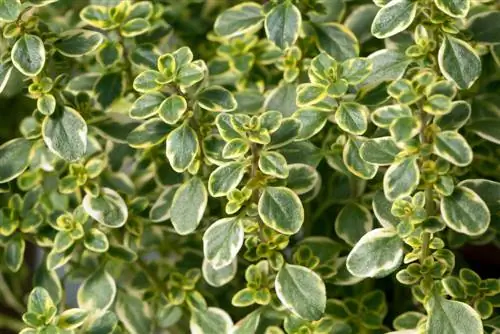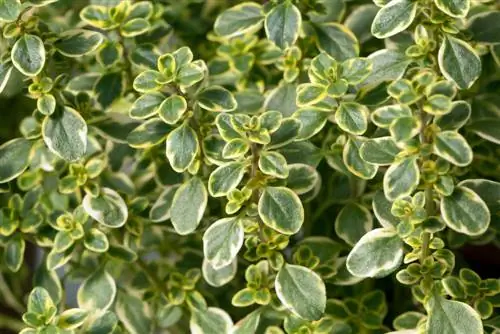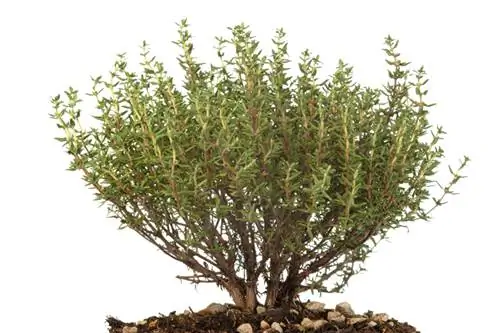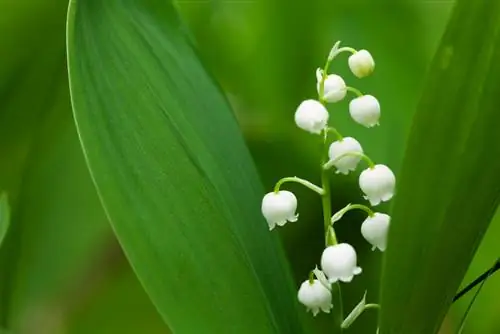- Author admin [email protected].
- Public 2023-12-16 16:46.
- Last modified 2025-06-01 06:02.
Read everything you need to know about lemon thyme in the commented profile here. Many tips on winter hardiness, flowering and use. How to plant and care for Thymus citriodorus correctly.

What is lemon thyme and how is it used?
Lemon thyme (Thymus citriodorus) is an evergreen, bushy-growing subshrub with a height of up to 20 cm. The plant is characterized by lemon-scented, edible leaves and purple-pink flowers. It is partially hardy and is suitable as a culinary herb, ground cover or container plant.
Profile
- Scientific name: Thymus citriodorus
- Family: Mint family (Lamiaceae)
- Growth type: Subshrub
- Growth: bushy, creeping
- Growth height: 8 cm to 20 cm (30 cm)
- Leaf: evergreen
- Flowers: fivefold, purple-pink
- Flowering period: June to September
- Harvest time: all year round
- Taste: lemony-fresh
- Winter hardiness: conditionally hardy
- Use: culinary herb, ground cover, potted plant
Bloom
From June onwards, lemon thyme is a popular destination for insects as the flowering period begins. Even from a distance, a seductive scent reveals the presence of the Mediterranean shrub in the garden and on the balcony. These characteristics characterize the flower of Thymus citriodorus:
- Flowering time: June to September (varieties in June and July)
- Flower shape: simple, cup-shaped, five-fold, in panicles
- Flower size: < 5 cm
- flower ecology: hermaphrodite
- Flower color: pink to purple in many shades
- Flower properties: lemon-like scent, edible
Leaf
Lemon thyme owes its status as a popular spice and ornamental plant to its leaves. The following overview sums up why this is so:
- Leaf shape: elliptical to obovate, entire, partially rolled leaf edge
- Sheet size: 10 mm to 15 mm long, 2 mm to 8 mm wide
- Leaf color: evergreen
- Leaf properties: lemon-scented, edible
- Taste: fruity-lemony, mildly aromatic, typical of thyme
The leaves are very stable and sit on low, square branches. Leaves and twigs form a resilient ground cushion that exudes an intense, lemon-like scent when stepped on.
Winter hardiness
Planted lemon thyme is hardy down to -18° Celsius. If the evergreen subshrub is cultivated in a bucket, its frost tolerance is reduced to -5° Celsius. Severe frost, persistent winter wetness and pot culture require simple protective measures, which you can read about in the care instructions below.
Usage
As a natural hybrid, lemon thyme impressively demonstrates what Mother Nature can conjure up for the garden. In fact, the cross between field thyme (Thymus pulegioides) and common thyme (Thymus vulgaris) was created without human intervention. Breeders took the pure species as a template for decorative varieties with variegated leaves. The result is a wide range of tasty, practical and decorative uses. The following table provides an insight:
| In the garden | In the bucket | For seasoning |
|---|---|---|
| Groundcover | Roof garden | Salad |
| walk-on lawn replacement | Balcony | Fish |
| Bed border | Terrace | Poultry |
| Herbal spiral | Herbal stairs | Vegetables |
| Bee Pasture | Flower box hanging plant | Tea, lemonade |
| Drywall | Bucket underplanting | Jam, jelly |
For your culinary inspiration, the following video introduces you to one of the many delicious lemon thyme recipes:
Harvest time
Lemon thyme is harvested all year round. The leaves are most aromatic shortly before the flowering period begins. Whatever the season, the perennial is rich in essential oils, including 0.5 percent thymol for the unique thyme flavor. The subshrub owes its tempting, lemon-like scent to a 60 percent proportion of geraniols and citral. The subshrub pumps a high concentration of these ingredients into its shoots and leaves before the lemon thyme flowers unfold.
Excursus
Aroma booster - dry lemon thyme
Gourmets harvest lemon thyme in early summer when it is most aromatic. The surplus harvest is dried as a tasty reserve for the barren winter period. In contrast to other culinary herbs, the lemony thyme aroma intensifies when you air dry the leaves, in the oven or in the dehydrator.
Planting lemon thyme
As a potted plant, you can buy lemon thyme during the gardening season and plant it in the ground. Vegetative propagation is cheaper and has a gardening fun factor. You can read how to successfully propagate Thymus citriodorus and plant it correctly here:
Propagate
Mediterranean herb plants, such as lemon thyme, sage or basil, can easily be propagated by cuttings. Vegetative propagation has the advantage that all the characteristics typical of the variety of the mother plant are retained. The best time is in spring. This is how it works:
- Fill growing soil into pots.
- Cut herbaceous, 10 cm long shoot tips as cuttings.
- Pluck the leaves from the lower half of the shoot.
- Place a cutting in the permeable soil in each pot
- Place the pot in a bowl with a transparent lid and pour in.
- Keep substrate slightly moist.
If there are fresh shoots on the cuttings, the cover has done its job. Care for the plants in a bright, not full sun location until the planting season begins in May.
Location
The best place for lemon thyme is in the rock garden in full sun. The mint also feels at home on the top floor of a herb staircase or herb spiral. All important location conditions at a glance:
- Sunny, warm location, preferably in front of a hot south-facing wall.
- Ideally protected from pelting rain.
- Soil texture: permeable, sandy-dry, calcareous, lean, low in humus.
Plant in the bed
Plant lemon thyme in the bed for use as a culinary herb or ground cover. The best time to plant is in spring. Because the roots grow quickly in permeable, loose soil, you can also plant the young plants in summer or autumn. The correct planting distance is 25 cm to 30 cm. For extensive greenery, plant 8 to 10 plants per square meter. Sprinkle each planting pit with sand or lava granules to prevent waterlogging in rainy weather.
Plant in a pot
Use an organic herb soil as a container substrate for carefree use as a culinary herb. Add a few handfuls of coconut fiber so that the substrate is well-drained and yet structurally stable. Cover the bottom of the pot with grit, expanded clay or pottery shards as drainage to prevent waterlogging. Plant the perennial as deep as before in the nursery pot. A pouring edge of 3 to 5 centimeters is advantageous. Pour thoroughly. In the first week, place the freshly planted lemon thyme in partial shade so that it does not suffer sunburn on its spicy leaves in full sun.
Care for lemon thyme
Lemon thyme is very easy to care for and the ideal starter plant for the herb garden. The water and nutrient supply is just as uncomplicated as the cutting care. Simple winter protection makes sense because the evergreen subshrub is not completely hardy. So that you can enjoy the spicy herbal pleasure for many years to come, please pay attention to these care tips:
Pouring
Summer drought is the only reason to water lemon thyme in the bed. Use hard tap water. In the pot in full sun, the soil dries out quickly. This also applies when a warm wind blows when the sky is overcast. Check watering needs every few days using a thumb test.
Fertilize
Fertilize lemon thyme every two weeks from May to August with an organic liquid fertilizer for herb plants. Because the subshrub mainly thrives in a creeping manner, adding compost and then incorporating it into the soil is not suitable. At the beginning of September, please stop the nutrient supply for bedding plants so that the shoots mature before the first frost.
Cutting and harvesting
If lemon thyme acts as a ground cover, pruning is not necessary. Regular harvesting of individual shoots is not sufficient as pruning care for use as a culinary herb. A vigorous pruning prevents the evergreen subshrub from becoming completely woody. How to do it right:
- Harvesting: Cut shoot tips in the morning when the morning dew has dried off.
- Pruning: in spring cut back all shoots by a third or half.
- Pruning guide: do not cut into the wood, thin out dead and unfavorable shoots at the base.
You can breathe new life into an old lemon thyme with a rejuvenating cut. The best time is in February. Cut the subshrub like real thyme back to just before the bare, woody area.
Wintering
For the certified winter hardiness of up to -18° Celsius, the roots must not be in water. To protect against winter waterlogging, cover lemon thyme in the bed with spruce brushwood. In winter, place a bucket on wood in a rain-protected niche. Cover the pot with fleece to prevent the root ball from freezing. Ideally, you should overwinter lemon thyme as a potted plant indoors in a bright and cool place at 5° to 10° Celsius.
Popular varieties
The best lemon thyme varieties are colorful in the garden and in containers, as the following selection proves:
- Golden Dwarf: cushion-forming growth with golden yellow leaves, violet flowers and a height of 5-20 cm.
- Variegatus: Premium variety with white-edged, spicy leaves, purple-pink flowers and a wonderful lemon scent.
- Aureus: partially upright growing golden lemon thyme, lilac flowers, height up to 30 cm.
- Cascata: Lemonade thyme, hanging or creeping, perfect for flavoring lemonade, juice and herbal tea.
- Silver King: decorative, green-white variety, pink flowers, clumpy to carpet-forming, aromatic, lemony scent.
FAQ
Which dishes can you season with lemon thyme?
With its lemon-like aroma, the Mediterranean herbal treasure gives savory and sweet dishes a special flavor. Lemon thyme goes well with poultry, fish, tarte flambée and mixed salads. Herbal tea, juice and lemonade get a fruity, fresh note with a few leaves of lemon thyme. Tasty and refreshing, the culinary herb rounds off sweet desserts and jams. Use the flowers as colorful cake decorations that can be eaten.
Can you propagate lemon thyme by sowing?
The seed-resistant original species Thymus citriodorus is primarily suitable for propagation by sowing. From March you can sow the seeds in bowls on the windowsill in permeable coconut soil. Do not cover the seeds because they germinate in the light. At normal room temperatures in a bright location, the germination time is four weeks. Cuttings are more suitable for propagating hybrids because the characteristics typical of the variety are retained.
Is lemon thyme hardy?
Because the evergreen subshrub comes from southern climes, it is not completely hardy in our latitudes. After all, lemon thyme bravely stands up to frosty temperatures down to -18° Celsius in the bed, as long as the roots are protected from winter moisture with brushwood. In the pot, the root ball is vulnerable to frost damage. Cover the vessel with fleece. A foot made of wood or Styrofoam protects the roots from frost from below.






